A toilet with a shelf: variants, typical problems, help in
What problems can create the owner of the Soviet toilet with a shelf, which is a separate item? What can it be replaced with? What are the signs of choosing a new compact? Let's figure it out.
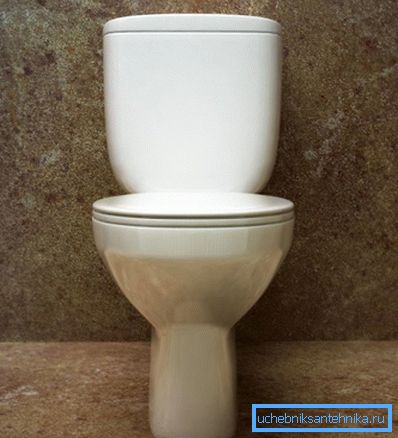
Classification
What toilets are supplied with a shelf? Obviously, all floor compacts with a lower tank: the shelf is a platform for mounting it. The top tank is mounted on the wall; hanging toilet means the hidden installation of the cistern in the wall.
Shelf
On sale under the common name can be found two radically different designs.
The shelf for the toilet bowl can be:
- Solid cast, part of the toilet bowl. Such a scheme is used in all imported and most domestic products.
- Separate. In this case, its release is connected to the toilet with a conical rubber cuff. Corresponding products are made exclusively in the post-Soviet space; Fortunately, they do not dominate the domestic market.
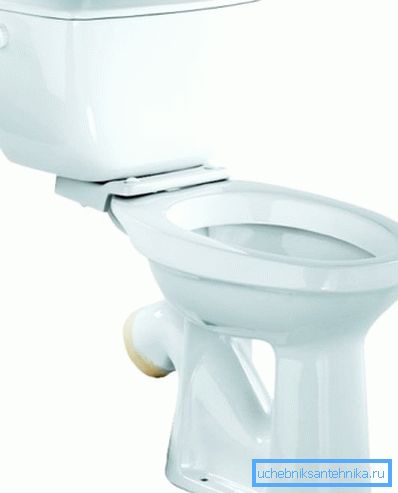
Release
When choosing a toilet bowl, the buyer will inevitably face the fact that different products have different forms of release.
- Oblique is characteristic of toilet bowls in most of the houses built in the Soviet Union, built after the 60s of the last century. Its great advantage is that even if the connection to the sewer socket is depressurized, there is no need to be afraid: when moving by gravity all the same, they will only get into the pipe.
- Vertical was used in even older houses (mainly in the Stalinist pre-war buildings). The socket in the floor is connected to the sewer riser (ladder), mounted under the ceiling of the lower apartment.
Curiously: toilets with vertical release are in demand not only among the residents of Stalinok, but also among the owners of cottages. They are convenient because they allow you to completely hide the communication.
- Horizontal (direct) release implies a hidden installation of sewage behind a false wall. It is connected to the horizontal socket of the sewer pipe with the sealing of the connection with a rubber cuff. However, toilets of this type can be connected to any bell corrugation - a flexible polyethylene pipe with rubber sealing rings.

Material
The most common solutions are:
- Faience. Its main advantage is the low price. The only material deficiency is relatively large pores, contributing to the rapid contamination of the surface.
By the way: glazed faience gets dirty much more slowly.
- Porcelain is as resistant to mechanical and chemical stress as the previous material, and more resistant to pollution due to its smaller pore size. The cost of porcelain compact is higher than faience, by 10-30%.
- Polymer concrete (also known as acrylic artificial stone), in comparison with ceramics, is more resistant to shock loads due to the viscosity of the binder. However, it is much worse tolerated by contact with acidic and abrasive cleaners. Coupled with a fairly high cost of material, this makes it a dubious choice.

Drain
It can be back and circular. The first one more effectively washes away the traces of using the toilet for its intended purpose; but the second washes all the surfaces in the bowl from the spray. An unambiguous instruction on the choice of one or another variant is impossible here: tastes do not argue.
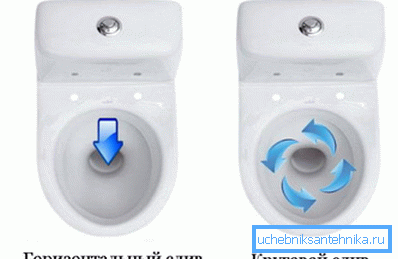
Bowl Shape
Among all possible forms, the best option is a water mirror located in front of the bowl with a steep slope of the back wall in its direction. The presence of an anti-splash system (a circular ledge just above the water level) is welcome. Such a scheme guarantees the absence of splashes when using the toilet.
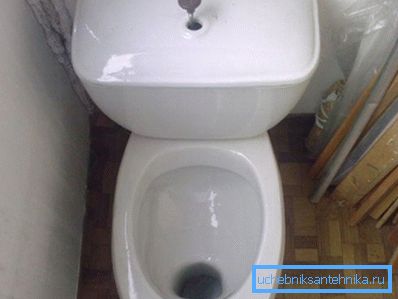
Problems and Solutions
First, about what problems the owner can create a separate shelf for an old-style toilet bowl, and how to fix them.
| Malfunction | Cause | Elimination |
| Flow under the shelf | Crack cuff connecting shelf and toilet | Cuff replacement |
| Destruction of steel bolts connecting the shelf with the tank | Replacement of bolts with washers and gaskets for brass; as an option - a complete replacement of a set of valves | |
| Leaking tank | Destruction of bolts mounting the saddle pear (drain valve) | Replacing bolts or replacing all fittings |
| Pear deformation | Pear substitute |

As always, when doing repair work with your own hands, you should take into account a number of subtleties.
- New cuff and pear should be as elastic as possible. Hard cuff is simply difficult to pull on the issue of the shelves and the bell of the toilet; tough pear will not block the water.
- When replacing the cuff, pull it over to release the shelves and roll up in the manner of a shirt sleeve; then, having set the tank in place, unfold the cuff, pulling it with the wide side onto the toilet bowl.
- A tank with a separate shelf must be provided with an additional support. Without it, when you visit the toilet, you risk having accidentally leaning back to hear the plaintive crunch of the ears of the toilet bowl or the shelf itself.
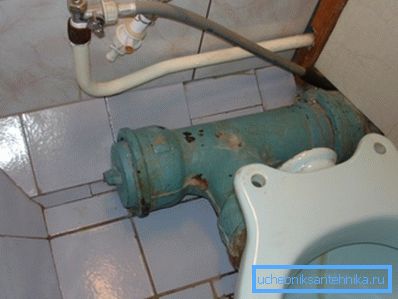
- A plastic seat with a shelf for the toilet and ears are tightened with either plastic bolts or metal bolts with rubber gaskets. The metal should not come into contact with ceramics: a slight deformation of the joint ensures cleavage. In this case, the mounting plate of the seat should be located between the ears of the toilet and the shelf, acting as a damper.
And what about the typical malfunctions of structures with solid shelves? It's very simple: they are not. Of course, the fittings themselves are quite capable of breaking down; However, the design features of the tank are not related to damage.
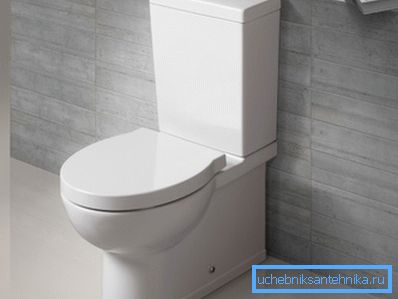
findings
Now we are more than easy to formulate the rules that should guide the choice of a new compact.
It should be:
- With a solid shelf.
- With a sloping descent to the water mirror located in front of the bowl and an anti-splash system.
- Made of porcelain or glazed faience.
You can get acquainted with the diversity of the modern plumbing market in more detail by viewing the video in this article. Successes!